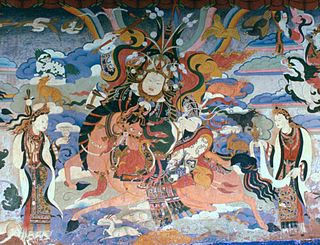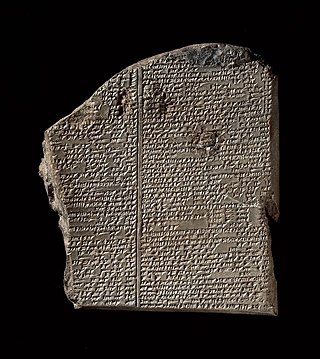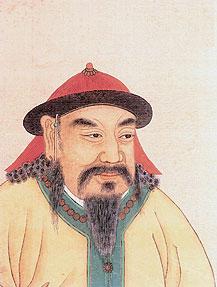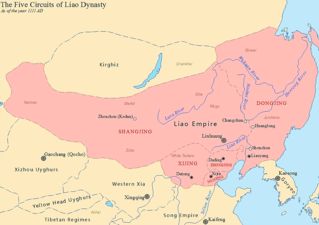
The Mahābhārata is one of the two major Smriti texts and Sanskrit epics of ancient India revered in Hinduism, the other being the Rāmāyaṇa. It narrates the events and aftermath of the Kurukshetra War, a war of succession between two groups of princely cousins, the Kauravas and the Pāṇḍavas.

The Ramayana also known as Valmiki Ramayana, as traditionally attributed to Valmiki, is a smriti text from ancient India, one of the two important epics of Hinduism known as the Itihasas, the other being the Mahabharata. The epic narrates the life of Rama, a prince of Ayodhya in the kingdom of Kosala. The epic follows his fourteen-year exile to the forest urged by his father King Dasharatha, on the request of Rama's stepmother Kaikeyi; his travels across forests in the Indian subcontinent with his wife Sita and brother Lakshmana; the kidnapping of Sita by Ravana, the king of Lanka, that resulted in war; and Rama's eventual return to Ayodhya along with Sita to be crowned king amidst jubilation and celebration.

Arjuna, also known as Partha and Dhananjaya, is a character of the Hindu epic Mahabharata. In the epic he is the third of five Pandava brothers, from the lineage of the Kuru. In the Mahabharata War, Arjuna was a key warrior from the Pandava side and killed many warriors. Before the beginning of the war, his mentor Krishna gave him the supreme knowledge of the Bhagavad Gita to overcome his moral dilemmas. Arjuna was the son of Kunti, the wife of Kuru King Pandu, and the god Indra, who fathered him due to Pandu's curse. Arjuna was the main protagonist of Mahabharata. In the Mahabharata, Arjuna is depicted as a skilled archer from an early age, as a student who earns the favor of his preceptor Drona, as the primary adversary of Kauravas, and the betrothed of Draupadi, who became the common wife of the Pandavas. Arjuna is twice exiled, first for breaking a pact with his brothers, and again with his brothers after his oldest brother is tricked into gambling away the throne. During his first exile, Arjuna married Ulupi, Chitrāngadā and Subhadra. From his four wives, Arjuna had four sons, one from each wife — Shrutakarma, Iravan, Babhruvahana and Abhimanyu. During his second exile, Arjuna gained many celestial weapons. Despite being a warrior, Arjuna also possessed skills in music and dance. At the end of the epic the Pandavas, accompanied by Draupadi, retire to the Himalayas, where everyone in time passes away to arrive in Heaven.

The Godfather Part III is a 1990 American epic crime film produced and directed by Francis Ford Coppola from the screenplay co-written with Mario Puzo. The film stars Al Pacino, Diane Keaton, Talia Shire, Andy García, Eli Wallach, Joe Mantegna, Bridget Fonda, George Hamilton, and Sofia Coppola. It is the third and final installment in The Godfather trilogy. A sequel to The Godfather (1972) and The Godfather Part II (1974), it concludes the fictional story of Michael Corleone, the patriarch of the Corleone family who attempts to legitimize his criminal empire. The film also includes fictionalized accounts of two real-life events: the 1978 death of Pope John Paul I and the Papal banking scandal of 1981–1982, both linked to Michael Corleone's business affairs.

Epic Records is an American record label owned by Sony Music Entertainment, a subsidiary of Sony Corporation of America, the American division of Japanese conglomerate Sony. The label was founded predominantly as a jazz and classical music label in 1953, but later expanded its scope to include a more diverse range of genres, including pop, R&B, rock, and hip hop.

The Epic of King Gesar, also spelled Kesar or Geser, is an epic from Tibet and Central Asia. It originally developed between around 200 or 300 BCE and about 600 CE. Following this, folk balladeers continued to pass on the story orally; this enriched the plot and embellished the language. The story reached its final form and height of popularity in the early 12th century.

The wind horse is a symbol of the human soul in the shamanistic tradition of East Asia and Central Asia. In Tibetan Buddhism, it was included as the pivotal element in the center of the four animals symbolizing the cardinal directions and a symbol of the idea of well-being or good fortune. It has also given the name to a type of prayer flag that has the five animals printed on it.
Qasar was one of Genghis Khan's three full brothers. According to the Jami' al-Tawarikh, his given name was Jo'chi and he got the nickname Khasar after his distinguished bravery. He was also called Habutu Hasar because he was skilled with a bow.

Turkic mythology refers to myths and legends told by the Turkic people. It features Tengrist and Shamanist strata of belief along with many other social and cultural constructs related to the nomadic and warrior way of life of Turkic and Mongol peoples in ancient times. Turkic mythology shares numerous ideas and practices with Mongol mythology. Turkic mythology has also been influenced by other local Asiatic and Eurasian mythologies. For example, in Tatar mythology elements of Finnic and Indo-European mythologies co-exist. Beings from Tatar mythology include Äbädä, Alara, Şüräle, Şekä, Pitsen, Tulpar, and Zilant.

Poetry as an oral art form likely predates written text. The earliest poetry is believed to have been recited or sung, employed as a way of remembering oral history, genealogy, and law. Poetry is often closely related to musical traditions, and the earliest poetry exists in the form of hymns, and other types of song such as chants. As such, poetry is often a verbal art. Many of the poems surviving from the ancient world are recorded prayers, or stories about religious subject matter, but they also include historical accounts, instructions for everyday activities, love songs, and fiction.
Üliger, tale is the general term given to tales and popular myths of the Mongols of north-east Asia. They are an important part of the oral traditions among the Buryats and other Siberian tribes, and among other functions, were used to orally transmit Buddhist birth stories. The tales are significant in Mongolian literature, given its long-standing tradition of passing stories on by word of mouth.

Shambhala Training is a secular approach to meditation and a new religious movement developed by Tibetan Buddhist teacher Chögyam Trungpa Rinpoche and his students. It is based on what Trungpa calls Shambhala Vision, which sees enlightened society as not purely mythical, but as realizable by people of all faiths through practices of mindfulness/awareness, non-aggression, and sacred outlook.

Shenlha Ökar or Shiwa Ökar is the most important deity in the Yungdrung Bon tradition of Tibet. He is counted among the "Four Transcendent Lords" along with Satrig Ersang, Sangpo Bumtri, and Tonpa Shenrab Miwoche.
Segeen Sebdeg, the 3rd of the 55 tenger of the western skies, is the Buryat god of winter, and "is married to Ugan Sesen ... ". Their daughter Sesegen Nogoon married Zasa Mergen Baatar.
Atai Ulaan, in Buryat mythology, is described as the leader of 44 Tenger (sky-gods) of the eastern skies, he is the leader of an army consisting of 6,666 soldiers.

Yesugei Baghatur or Yesükhei was a major chief of the Khamag Mongol confederation and the father of Temüjin, later known as Genghis Khan. He was from the Borjigin family, and his name means "like nine", meaning he had the auspicious qualities of the number nine, a lucky number to the Mongols.
Mergen is a Turkic deity of abundance and wisdom. Mergen is often depicted with a bow and arrow in one hand. Other important symbols include a white horse and the color white. He is associated with profundity and depicted as a strong and powerful god. Mergen is the son of Kayra and the brother of Ulgan, and lives on the seventh floor of sky. He was portrayed as a young man with a helmet and a bow riding on a white horse. Mergen symbolizes intelligence and thought.

Buhe or Bu He, also known as Yun Shuguang, was a Chinese politician of Mongol descent. The eldest son of the powerful Inner Mongolia leader Ulanhu, Buhe served as Chairman of Inner Mongolia Autonomous Region between 1982 and 1993. Between 1993 and 2003 he was Vice Chairman of the National People's Congress.

This is a timeline of Mongols prior to the Mongol Empire.
The Rich Khan Badma is a Buryat folktale, first collected by Buryat ethnographer and folklorist Matvei N. Khangalov. The tale is related to the theme of the calumniated wife and classified in the Aarne-Thompson-Uther Index as type ATU 707, "The Three Golden Children". Similar tales are found among other Mongolic peoples, sharing some of its motifs.